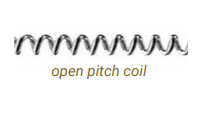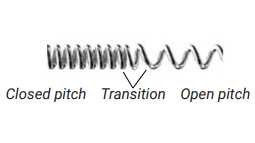GLOSSARY OF Coil Winder TERMS
Arbor: (same as a mandrel) A metal rod that shapes coils by having the wire wrapped around it.
Arbor Tension: The tension applied to the arbor during the winding process. This is necessary to keep the wire payout operating in a smooth manner. The tension setting is adjustable.
Automatic Coil Winder: A coil winding machine that once loaded with wire and properly set up will continuously manufacture and deliver the desired coil until the wire runs out.
Brakes: There are two types of brakes used on coil winding machines, Electronic and Manual. The brakes keep a constant set tension on the wire as it unrolls from the spool. This is done by applying a load to the rotation of the spool spindle shaft.
Carriage: This is the platform on the linear actuator that traverses left/right where the wire payout rack is mounted.
Catheter: A tube that can be inserted into a body cavity, duct or vessel. Catheters can allow drainage, administration of fluids or gases or access by surgical instruments.
Closed Pitch: (also called tight wound) A coil that is wound with no spacing between the wire.

Coil: A winding consisting of a series of loops or circles made around an arbor
Coil Index: The ratio of a finished coil outer diameter to the diameter of the wire used to make the coil:
Coil outer diameter : Wire Diameter = Index
Collet: This is a clamping device similar to a chuck (i.e. an Albrecht chuck). This is used to clamp onto the arbor or arbor/coil assembly during winding.
Compensator: A feedback module that performs a lead/lag correction of the wire angle as the wire is wound around the arbor.
Continuous Winding: A coil winding process that once loaded with wire and properly set-up, will manufacture the desired coil without interruption until the wire runs out.
Cutters: (automatic) Cutting blades used to cut coils when operating in an automatic mode.
Droop Specification: The measure of stiffness of the wound coil.
Dual Arbor Coil Winding Machine: A coil winding machine that can produce two identical coils at the same time.
Electronic Wire Tensioning: The holding torque applied by an electronic brake to a shaft that holds the wire spool resulting in an applied tension to the wire.
Endoscope: A medical device with a light attached that is used to look inside a body cavity or organ. The scope is inserted through a natural opening such as the mouth for a bronchoscope.
Guide Wire: In medical applications, a wire that is inserted to guide a catheter to a certain location in the body.
High Speed Spindles: The rotary device that holds the collet or chuck to allow rotation of the arbor.
Joystick: A device similar to the control used in video games. All RothGreaves winders come with a remote joystick which enables the operator to move around and control the winder.
Linear Actuator: The translational device used to position the carriage and to move it during coil winding.
Linear Encoder: A feedback device that has a read head paired with a scale that encodes position. This allows for exact position location of the carriage.
Mandrel: Another name for an arbor.
Manual Wire Tensioning: The holding torque applied to the payout spool via a manually adjusted friction brake resulting in tension on the wire payout.
Medical Coil: A coil that is used in a medical device.
Medical Coil Winder: A coil winder that can produce a medical coil. Example; RothGreaves & Associates, Inc. coil winder.
Micro-Coil: A small diameter coil wound on small diameter arbor with small diameter wire. An example of a micro coil would be a 0.007” diameter coil using 0.001” wire. All RothGreaves coil winders can make Micro-Coils.
Multi Filar: A coil with more then one wire used to form the coil.
Nitinol: A metal alloy consisting of Nickel and Titanium which has two unique properties: shape memory and super-elasticity.
Open Pitch: Also called space wound and open wound. This is a coil that is wound with a gap between each wire wrap.

Over Winding: The winding of a second coil on top of another coil.
Payout Angle: This is the angle of the wire to the arbor as the coil is being wound.
Payout Spindle: The spindle shaft on the payout rack that holds the wire spool.
Pitch: This is the distance between each wire wrap measured in inches/revolution or mm/revolution.
Pre-Tensioned Coil: A coil wound with some amount of back angle to produce a stiffer coil.
Single Filar: A coil with one wire used to form the coil.
Stent: A medical device inserted into a natural passage / conduit in the body to prevent or counteract a disease-induced, localized flow constriction.
Stress Relieving: The removal of minor stress in the wire using heat such as delivered from a hot air torch.
Tailstock: The movable motor/chuck assembly that clamps onto the right end of the arbor as found on RothGreaves winding machines.
Torch: This is similar to a hot air gun. The torch directs heated air at the wire being wound. Certain manufacturing processes require the wire to be heated prior to being wound.
Torque Coil: A coil or coil assembly that can transmit torque.
Transition: The area where a coil undergoes a change in pitch.

Wire Profiles: The cross sectional shape of a wire used to make a coil. There are three basic types; 1) Round 2) Rectangular and 3) Square.
